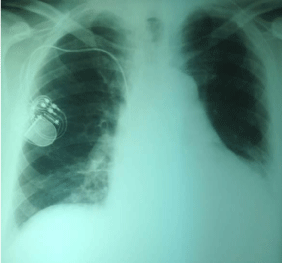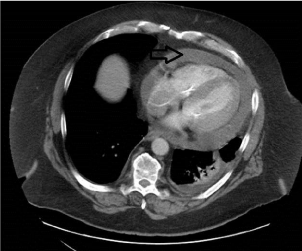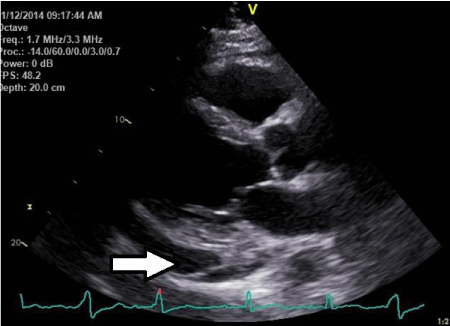
Case Report
Austin Cardio & Cardiovasc Case Rep. 2017; 2(1): 1015.
Rivaroxaban and Hemopericardium – Is There an Association?
Gowani SA1, Omar S¹, Elmahdy HM², Kherada N¹, Sekhon A¹, Conde C¹ and Santana O¹*
¹The Columbia University Division of Cardiology, Mount Sinai Heart Institute, Miami Beach, Florida, USA
²Department of Internal Medicine at Mount Sinai Medical Center, Miami Beach, Florida, USA
*Corresponding author: Orlando Santana, Echocardiography Laboratory, Columbia University Division of Cardiology, Mount Sinai Heart Institute, Miami Beach, Florida, USA
Received: February 20, 2017; Accepted: March 14, 2017; Published: March 20, 2017
Abstract
Newer oral anticoagulants are being used more frequently in patients with non-valvular atrial fibrillation. Rivaroxaban is one of the new oral anticoagulants which acts as a direct factor Xa inhibitor. The overall bleeding risk from using rivaroxaban in patients with atrial fibrillation is 14.9%/year, and the risk of any major bleed is 3.6%/year. We present a case of a 68 years old gentleman patient who underwent recent atrial lead re-positioning and developed hemopericardium in the setting of pericarditis.
Keywords: Atrial fibrillation; Rivaroxaban; Hemopericardium; Direct Xa inhibitors
Introduction
Atrial fibrillation has been described as a growing epidemic that will affect a quarter of adults older than 40 years of age [1]. Rivaroxaban is one of the newer oral anticoagulant approved for use in the patients with non-valvular atrial fibrillation [2]. It has also been approved for other indications (Table 1). Its use has increased owing to its rapid onset of action, predictable therapeutic level, ease of standard dose administration without the need for monitoring laboratory tests and limited interaction with other drugs [3]; however, as with all anticoagulants, there is a risk of bleeding complications.
1. Non-valvular atrial fibrillation
2. Deep venous thrombosis treatment and prevention of recurrence
3. Pulmonary embolism treatment and prevention of recurrence
4. Deep venous thrombosis prophylaxis after hip and knee surgery
Table 1: Rivaroxaban Indications.
Case Presentation
A 68 years old male with hypertension, obstructive sleep apnea, paroxysmal atrial fibrillation on rivaroxaban, sick sinus syndrome with implanted permanent pacemaker presented with progressive chest pain and exertional dyspnea for 1 week. He had the permanent pacemaker implanted 6 months prior. The procedure was complicated by dislodgement of the right atrial lead on postoperative day 1, which required repositioning. He was also switched from warfarin to rivaroxaban at the same time due to difficulty in maintaining a therapeutic INR. A few months later he developed chest pain, which was sharp, centrally located and radiated to the left shoulder. It worsened with deep inspiration and improved with sitting and leaning forward. On physical examination, his blood pressure was 109/56mmHg, heart rate 95 beats per minute and an oxygen saturation of 96% on room air. Cardiovascular examination showed an elevated jugular venous pressure, distant heart sounds and a pericardial rub. No additional heart sounds or murmurs were noted. The lung examination revealed decreased breath sounds over the left lung base. The rest of the physical exam was unremarkable. The initial laboratory testing revealed: ESR 122 mm/hr, CRP 206 mg/L. The chest x-ray revealed cardiomegaly, with a globular heart suggestive of a pericardial effusion (Figure 1). A computerized tomographic scan of the chest ruled out a pulmonary embolism and aortic dissection, but demonstrated amoderateto large sized pericardial effusion, heterogeneous in nature suggestive of blood. A left sided pleural effusion was present, and the pacemaker leads were in their proper location (Figure 2). A transthoracic echocardiogram performed demonstrated a moderately sized pericardial effusion without evidence of tamponade, and an ejection fraction of 55% (Figure 3). The rivaroxaban was held out of concern of a hemopericardium, and was started on anti-inflammatory medications for pericarditis. His symptoms failed to resolve with conservative management. On day 3, a left anterior thoracotomy with a pericardial window was performed, and 600 cc of blood was drained. Moreover, 400 cc of serous fluid was drained from the left pleural space and a chest tube was left in place. The chest tube was removed 2 days later. The pericardial fluid was grossly bloody. The analysis showed a red blood cell count of 70500 cells/micro liter, a white blood cell count of 3500 cells/micro liter with 31% polymorph nuclear leukocytes. The pericardial fluid culture was negative for bacterial or fungal infections. The cytology was negative for malignant cells. The patient had resolution of his chest pain and dyspnea during the hospital stay. The rivaroxaban was resumed postoperatively and he was discharged on colchicine. At 3 month followup, the patient was asymptomatic and had not had recurrences of the pericarditis.

Figure 1: Chest x-ray revealed cardiomegaly, globular heart with left pleural
effusion.

Figure 2: Computerized tomographics can of the chest demonstrating a
moderately sized pericardial effusion (arrow).

Figure 3: Transthoracic echocardiogram-Parasternal long axis showing a
moderately sized pericardial effusion (arrow).
Discussion
Various anticoagulants have different bleeding risk profile and bleeding complications. Hemopericardium is a known bleeding complication for patients on anticoagulants including warfarin [4]. Hemopericardium is a rare, but important complication that has been reported with some of the new oral anticoagulants such as with rivaroxaban and dabigatran [5,6]. However, in this case, given the possible chronicity of the pericardial effusion, it may be that rivaroxaban potentiated rather than initiated the pericardial effusion. The patient may have had an element of pericarditis after the time of his pacemaker implant and lead re-positioning, which subsequently became hemorrhagic after initiating rivaroxaban.
Shivamurthy et al, reported a case report revealing an association between rivaroxaban and hemopericardium [5]. The case involved a typical presentation of pericarditis along with herbal supplementation; namely Saw Palmetto (reducing clearance of rivaroxaban) leading to hemopericardium [5]. It is not reported that Saw Palmetto can cause pericarditis but easy bruising or bleeding is one of the side effects. The present case demonstrates similar finding with pericarditis being the trigger and facilitating hemopericardium in the setting of inflammation. This goes along with the proposed mechanism of rivaroxaban possibly being a facilitator in the process of a hemopericardium rather than an initiator.
Conclusion
Hemopericardium is an uncommon bleeding complication of rivaroxaban use. Hence, it is important to consider hemopericardium as a differential for patients presenting with chest pain and dyspnea, especially on anticoagulants.
References
- Kirchhof P. Integrated care of patients with atrial fibrillation: the 2016 ESC atrial fibrillation guidelines.
- Patel MR, Mahaffey KW, Garg J, Pan G, Singer DE, Hacke W, et al. ROCKET AF Investigators. Rivaroxaban versus warfarin innonvalvular atrial fibrillation. N Engl J Med. 2011; 365: 883-891.
- Adam SS, McDuffie JR, Ortel TL, Williams JW. Comparative effectiveness of warfarin and new oral anticoagulants for the management of atrial fibrillation and venous thromboembolism: a systematic review. Ann Intern Med. 2012; 157: 796-807.
- Palareti G. Direct oral anticoagulants and bleeding risk (in comparison to vitamin K antagonists and heparins), and the treatment of bleeding. Semin Hematol. 2014; 51: 102-111.
- Shivamurthy P, Brar N, Therrien ML. Isolated hemopericardium associated with rivaroxaban: first case report. Pharmacotherapy. 2014; 34: 169-172.
- Barton CA, McMillian WD, Raza SS, Keller RE. Hemopericardium in a patient treated with dabigatran etexilate. Pharmacotherapy. 2012; 32: 103-107.